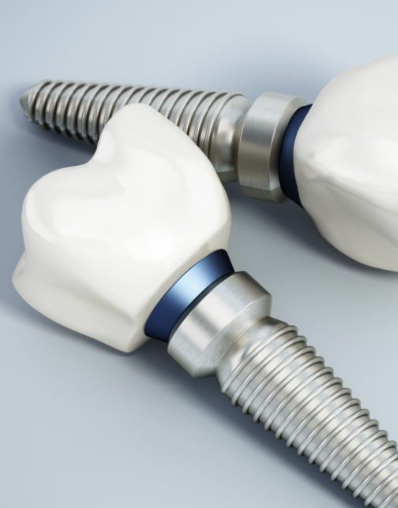Home of Dental Implants
Missing teeth, affecting your smile and eating habits? Reclaim your confidence and functionality at Amo Clinic. Our premium, lifelong guaranteed dental implants restore aesthetics and ensure optimal oral health. Say goodbye to gaps and hello to a vibrant, comfortable smile. Book your free consultation now!

Benefits of Dental Implants
Indulge in the enduring benefits of our dental implants, offering a natural-looking solution that not only restores your smile but also prevents bone loss, facial sagging, and aging, while maintaining the harmony and confidence in your overall oral health.
- Provides a long-term solution for missing teeth
- They look and behave like natural teeth
- Returning the mouth to its most natural state
- Preventing further bone loss
- Prevention of facial sagging and premature aging
- Keeping teeth adjacent
- Reconstruction of the aesthetics of a smile
- Rebuilding our patients’ confidence and self-esteem
Enhanced smiles with dental implants









Amo Clinic is the best dental clinic in Albania for dental implants with the highest success rate.
A dental implant is a titanium post that is surgically placed in the jawbone as a support for a replacement tooth. Unlike removable dentures or bridges, dental implants offer stability, superior functionality and will not affect other healthy teeth. Your implants will mimic the strength of your natural teeth and preserve the vitality of your jawbones.






What is a Dental Implant?
Today, dental implants, typically made from well-tolerated titanium or its alloys, form a close connection with the bone, known as “osseointegration,” essential for supporting replacement teeth. Functioning as a substitute for natural roots, these cone or cylinder-shaped implants are precisely positioned to achieve immediate contact with the surrounding bone, fostering primary stability and encouraging further bone growth. Equipped with a threaded channel, dental implants accommodate various components, serving as the foundation for crowns, bridges, and prostheses.
How many teeth can an implant hold?
Dental implants offer a comprehensive solution for tooth replacement, replacing common alternatives like dentures or bridges. For single-tooth replacement, one implant suffices, while larger gaps due to multiple missing teeth may require a variable number of implants, contingent on the bone quality and volume at each location. In specific cases, natural teeth can be joined with implants using a conventional fixed bridge. In the upper jaw, where the bone is softer, a minimum of 6 implants is typically recommended to replace 10-12 teeth.
What else can be achieved with dental implants?
For those without lower jaw teeth, a conventional lower prosthesis can be supported by two front implants, with a similar solution possible for the upper jaw, albeit requiring more implants due to softer bone. Immediate tooth placement after implantation is feasible in some cases, but patients must weigh the trade-off between expedited treatment and a heightened risk of implant failure. Dental implants adhere to basic engineering principles, necessitating placement on sturdy foundations in an adequate quantity to prevent overloading, while also ensuring easy cleaning for a healthy surrounding bone and gingiva.
Which one is suitable for dental implants?
Maintaining good oral hygiene is crucial for the success of dental implants, but habits like smoking and alcohol consumption can pose challenges for primary healing and implant longevity. After tooth loss, immediate implant placement or placement a few weeks later can minimize rapid bone loss. For prosthetics, stability often declines in the first six months to a year due to rapid bone loss, requiring resizing procedures. Long-term prosthesis wearers may have limited bone for implants, making implants beneficial for preserving alveolar bone strength and density.
What if an implant fails?
An implant can fail immediately after the intervention or some time after the placement of the fixed work on it. In general, the failed implant does not cause any discomfort.
Failures are not always easily acceptable by us, but if we agree to this type of treatment, we must be prepared for such a fact.
In the general statistics, losses are described to the extent of much less than 5% of cases.
In the statistics of our clinic, since 2005, failures in implanology are up to now at the rate of 2%.
It is a very good thing to discuss with the doctor how planning and treatment affects the failure of an implant.
How long do implants last?
The correctness and precision of the placement of the work (teeth) as well as the success of each stage at this stage will be the main factor that will determine the performance of the implants. If the implants are surrounded by a normal gingiva and the daily and regular cleaning is carried out patiently by you, this will directly affect their lifespan.
Well-maintained implants placed in the right bone can have a long life, perhaps for a lifetime
Is it difficult to place implants?
We are all aware of how valuable local anesthesia is used in daily dental practice. Implant placement is done under the same anesthesia and lasts from 30 minutes for the placement of a simple implant to several hours for more complicated procedures such as several implants or bone grafts. It is normal to have some edema after the intervention. The sutures are removed one week later. During the first days it is normal to feel discomfort and a little pain. It is important to follow all the instructions given after the intervention. If you are in doubt, do not hesitate to ask the doctor.
What if the bone is not strong enough?
It is not always possible to place implants. This is due to the lack of sufficient bone in the jaw. In the upper jaw, it is possible to increase the amount of bone through the creation of a new bone in the maxillary sinus. The procedure is called “sinus augmentation”. A skilled surgeon can achieve predictable results in this area and without the success of this technique for many patients it would be impossible to have implants in this part of the mouth where teeth are often lost. Bone graft only. There are many ways to add bone to an area where we need it. The most common is taking a piece of bone from another part of the body and placing it where we need it.




